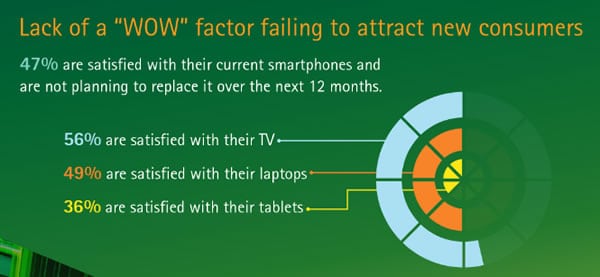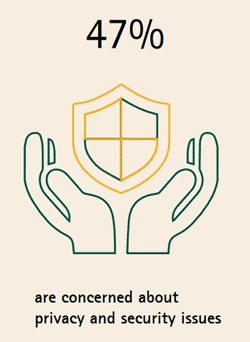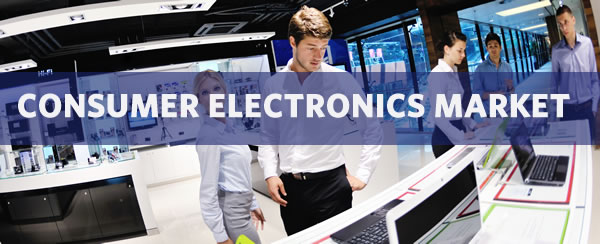In many industries initiatives are taken to engage consumers in entirely new ways. Smartphones and other smart devices are key in many of these scenarios, whereby the Internet of Things (IoT), data-driven activities and mobility are never far away. However, the consumer electronics market is going through turbulent times.
How fast are consumers going to adopt ever ‘smarter’ devices and what is the outlook for the consumer electronics market in general? In a series of articles we look at the key evolutions across several traditional consumer electronics categories and ‘emerging’ consumer electronics categories. Because, in the end, it’s the adoption of specific devices that will co-define how organizations can move and succeed or at least adapt in a consumer reality with new – connected – possibilities. And if consumers don’t trust you with their data and refrain from buying those consumer electronics goods which will offer new sources of data and means to leverage them, initiatives you have planned might just not work.
In this first article we tackle some key challenges and evolutions in the consumer electronics industry, which is going through digital transformations as well, before diving deeper into specific categories.
2016: not the best year ever for the consumer electronics industry
The consumer electronics market was expected to face a few difficult years, starting with 2016.
Growth had declined in several categories and, while waiting for higher growth in newer consumer electronics categories to compensate for these slowdowns, the market was confronted with several challenges.
At the occasion of the edition 2016 of that big annual consumer electronics show, (CES), Accenture released a new edition of its Digital Consumer Survey for communications, media and technology companies.
According to Accenture a decade of unprecedented growth in consumer electronics had come to an end, mainly because the smartphone market had hit maturity so the industry knew what was coming, especially as growth stalled in all other traditional categories too.
Focus on new consumer electronics categories and connected devices
When you look at the media attention in regards with new consumer electronics products and categories, you see VR, AR, drones, wearables, smart home automation solutions and a bunch of products which are inevitably related with the Internet of Things.
There is clearly a difference between media attention and the reality in the market. While media talk about Consumer Internet of Things innovations, applications and gadgets on an almost daily basis, we know that in practice the interesting and most important evolutions are happening in the Industrial Internet of Things.
For mainstream media it doesn’t matter whether we’re talking about a connected fitness tracker, a next gen smart wearable or a smart city application: it’s all categorized under this big umbrella term, the Internet of Things. And that could be a showstopper as we’ll see.

Do consumers feel more confident regarding new electronics?
The reason we mention the Internet of Things is that Accenture urged the consumer electronics industry in its 2016 report to meet consumer concerns and barriers regarding IoT better in order to bridge the current period of slowdown in consumer electronics growth and the next stage, when consumers do start massively buying products in new categories, where the Internet of Things (IoT) plays a big role. Because that growth will come.

Yet, the fact that since the end of Summer of 2016 the media have reported non-stop on the security dramas and the security risks and challenges regarding the Internet of Things (and even simple webcams) didn’t exactly help in taking away the security concerns of consumers. For them, just as for mainstream media, the Internet of Things is just a thing and a connected device is a connected device, period.
That’s bad news for the consumer electronics industry because the Accenture report found that 47 percent of consumers had security and privacy concerns regarding IoT-enabled and connected consumer electronics devices.
With more cyberattacks and data breaches than ever, as well as recent reports on how some companies deal with consumer data, concerns regarding data and data privacy probably didn’t improve a lot either.
What’s next for the consumer electronics industry?
Looking at these factors, the geopolitical climate, the lack of products with a ‘wow’ factor, the problems encountered by a few vendors (just think how Samsung dominated the bad news headlines) and the fact that there is no compelling new event or amazing new experience offered by any manufacturer and the picture doesn’t seem to look much better than early 2016.
Moreover, later in 2016 we saw how for the second year in a row tablet sales went down, the smartwatch market declined for the first time ever and sales of smart wearables stalled, to give just a few examples from IDC, which we’ll tackle in the various overviews of specific consumer electronics categories.
What’s the industry to do? Accenture had already found that consumer demand was sluggish across all consumer electronics categories, from smartphones, laptops and tablets to televisions. And, as said, these newer categories such as smart watches or drones didn’t grow fast enough to compensate the declines across the traditional consumer electronics categories. So it was time to act and Accenture’s report gave a bunch of advice to do just that.
However, with all the mentioned challenges 2016 has brought upon us, the question still might not be whether the growth of new consumer electronics categories will pick up suddenly and fast but rather how long it will take.
On the other hand, just as Accenture said in its 2016 ‘Igniting Growth in Consumer Technology’ report that it isn’t all doom and gloom, so have several analysts. While some consumer electronics categories will continue to suffer for a while and others might have to wait a bit longer before really growing there are several bright spots – and a lot of advice and lessons to be learned for the industry in 2017 and beyond – as we’ll see next.
Stay tuned for data and findings across several categories.

Top image: Shutterstock – Copyright: dotshock – All other images are the property of their respective mentioned owners.


